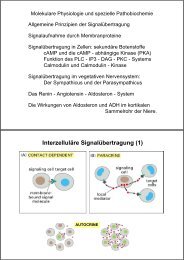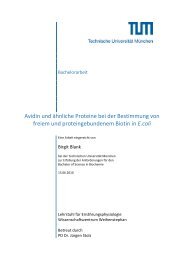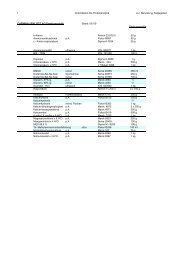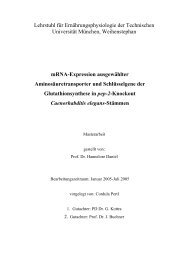Review The role of insulin and IGF-1 signaling in longevity
Review The role of insulin and IGF-1 signaling in longevity
Review The role of insulin and IGF-1 signaling in longevity
Create successful ePaper yourself
Turn your PDF publications into a flip-book with our unique Google optimized e-Paper software.
CMLS, Cell. Mol. Life Sci. Vol. 62, 2005 <strong>Review</strong> Article 331<br />
cantly higher than controls after treatment with low doses<br />
<strong>of</strong> H 2O 2. Besides reduction <strong>of</strong> <strong>IGF</strong>-1R levels <strong>and</strong> <strong>IGF</strong>-1<strong>in</strong>duced<br />
tyros<strong>in</strong>e phosphorylation <strong>of</strong> <strong>IGF</strong>-1R <strong>and</strong> IRS1,<br />
<strong>IGF</strong>-1-stimulated tyros<strong>in</strong>e phosphorylation <strong>of</strong> the p52 <strong>and</strong><br />
p66 is<strong>of</strong>orms <strong>of</strong> Shc is also reduced by 50%, <strong>in</strong>dicat<strong>in</strong>g a<br />
l<strong>in</strong>k between Shc activation <strong>and</strong> mechanism by which<br />
<strong>IGF</strong>-1 regulates oxidative stress resistance <strong>in</strong> the mice.<br />
It has been shown previously that mice with a targeted<br />
disruption <strong>of</strong> the p66Shc gene have <strong>in</strong>creased stress resistance<br />
<strong>and</strong> prolonged lifespan by ~30% [274]. In addition,<br />
deletion <strong>of</strong> the p66Shc gene reduces systemic <strong>and</strong> tissue<br />
oxidative stress, vascular cell apoptosis <strong>and</strong> early atherogenesis<br />
<strong>in</strong> mice fed with high-fat diet [275]. It has been<br />
shown that a fraction <strong>of</strong> cytosolic p66Shc localizes with<strong>in</strong><br />
mitochondria where it forms a complex with mitochondrial<br />
heat shock prote<strong>in</strong> 70 (Hsp 70) <strong>and</strong> regulates transmembrane<br />
potential <strong>and</strong> apoptosis [276]. S<strong>in</strong>ce it is suggested<br />
that mitochondria regulate lifespan through their<br />
effects on the energetic metabolism, p66Shc could contribute<br />
to lifespan determ<strong>in</strong>ation by mitochondrial regulation<br />
<strong>of</strong> apoptosis.<br />
Interest<strong>in</strong>gly, a relation between p66Shc <strong>and</strong> FKHR-L1<br />
(FOXO3a), a member <strong>of</strong> the forkhead (FOXO) family <strong>of</strong><br />
transcription factors, has been also established. By comparison<br />
with the Daf2/Daf16 pathway <strong>in</strong> C. elegans, one<br />
would expect that greater activity <strong>of</strong> Daf-16-related<br />
FOXO transcription factor should result <strong>in</strong> an extension<br />
<strong>of</strong> mammalian lifespan. p66Shc is activated by Ser36<br />
phosphorylation after UV irradiation or oxidant stimulation<br />
[274], <strong>and</strong> this is associated with an <strong>in</strong>activation <strong>of</strong><br />
FOXO transcription factors via phosphorylation, probably<br />
mediated by Akt [277]. FOXO3a tends to stimulate<br />
survival <strong>and</strong> resistance responses under oxidative stress,<br />
<strong>and</strong> its <strong>in</strong>activation <strong>in</strong>duces apoptosis [277]. Lack <strong>of</strong><br />
p66Shc, therefore, could contribute to the <strong>in</strong>creased<br />
<strong>longevity</strong> by this mechanism. In addition, FOXO3a stimulates<br />
the DNA repair pathway through Gadd45a prote<strong>in</strong>,<br />
which could be the possible mechanism <strong>in</strong>fluenc<strong>in</strong>g lifespan<br />
[208].<br />
<strong>The</strong>re are three mammalian homologues <strong>of</strong> Daf-16 [197,<br />
278, 279]: FOXO1 (or FKHR), FOXO3a (or FKHR-L1)<br />
<strong>and</strong> FOXO4 (AFX). Follow<strong>in</strong>g stimulation by growth<br />
factors or cytok<strong>in</strong>es, FOXOs are <strong>in</strong>hibited <strong>in</strong> most mammalian<br />
cells <strong>and</strong> tissues [197, 278, 280]. Although activation<br />
<strong>of</strong> this family <strong>of</strong> prote<strong>in</strong>s has a clear effect on cellular<br />
lifespan, the specific <strong>role</strong>s <strong>of</strong> FOXO is<strong>of</strong>orms are still<br />
not fully understood, <strong>and</strong> mice lack<strong>in</strong>g the three ma<strong>in</strong> is<strong>of</strong>orms<br />
display remarkably different phenotypes [281].<br />
Foxo1 homozygous knockout mice die before birth,<br />
whereas heterozygous Foxo1 mice are healthy <strong>and</strong> protected<br />
aga<strong>in</strong>st the development <strong>of</strong> diabetes <strong>in</strong>duced by<br />
heterozygous deletion <strong>of</strong> the <strong><strong>in</strong>sul<strong>in</strong></strong> receptor <strong>and</strong> <strong><strong>in</strong>sul<strong>in</strong></strong><br />
receptor substrate gene [282, 283]. In contrast, FOXO3a<br />
null mice have relatively few defects [284], <strong>and</strong> FOXO4<br />
null mice have no obvious phenotype [281].<br />
While the <strong>role</strong>s <strong>of</strong> <strong><strong>in</strong>sul<strong>in</strong></strong> <strong>signal<strong>in</strong>g</strong> <strong>in</strong> glucose metabolism<br />
<strong>and</strong> development <strong>of</strong> diabetes mellitus <strong>in</strong> mice have<br />
been studied <strong>in</strong> detail [285–287], exam<strong>in</strong>ation <strong>of</strong> the effects<br />
<strong>of</strong> <strong><strong>in</strong>sul<strong>in</strong></strong> on <strong>longevity</strong> <strong>and</strong> ag<strong>in</strong>g <strong>in</strong> mammals has<br />
been relatively recent. <strong>The</strong> hypothesis that <strong><strong>in</strong>sul<strong>in</strong></strong> is <strong>in</strong>volved<br />
<strong>in</strong> mammalian ag<strong>in</strong>g has evolved from several<br />
studies. In the Snell Dwarf mice, GH deficiency leads to<br />
reduced <strong><strong>in</strong>sul<strong>in</strong></strong> release <strong>and</strong> alterations <strong>in</strong> <strong><strong>in</strong>sul<strong>in</strong></strong> <strong>signal<strong>in</strong>g</strong>,<br />
<strong>in</strong>clud<strong>in</strong>g decreased IRS-2, <strong>and</strong> reduced PI 3-k<strong>in</strong>ase<br />
activity [288]. By contrast, <strong>in</strong> liver <strong>of</strong> Ames Dwarf mice<br />
<strong><strong>in</strong>sul<strong>in</strong></strong> sensitivity is <strong>in</strong>creased with concomitant <strong><strong>in</strong>sul<strong>in</strong></strong><br />
receptor, IRS-1 <strong>and</strong> IRS-2 upregulation <strong>and</strong> lower levels<br />
<strong>of</strong> <strong><strong>in</strong>sul<strong>in</strong></strong> [289]. This is similar to the improved <strong><strong>in</strong>sul<strong>in</strong></strong><br />
sensitivity <strong>in</strong> calorie-restricted animals that have <strong>in</strong>creased<br />
lifespan.<br />
In the mouse, genetic disruption <strong>of</strong> the <strong><strong>in</strong>sul<strong>in</strong></strong> receptor or<br />
prote<strong>in</strong>s <strong>in</strong>volved <strong>in</strong> <strong><strong>in</strong>sul<strong>in</strong></strong> <strong>signal<strong>in</strong>g</strong>, either <strong>in</strong> the whole<br />
body or specific organs usually leads to <strong><strong>in</strong>sul<strong>in</strong></strong> resistance<br />
<strong>and</strong> the tendency to develop diabetes [288]. In most<br />
cases, the effect on <strong>longevity</strong> is unknown. On the other<br />
h<strong>and</strong>, mice with fat-specific disruption <strong>of</strong> the <strong><strong>in</strong>sul<strong>in</strong></strong> receptor<br />
gene (FIRKO) are born with the expected frequency,<br />
survive well after wean<strong>in</strong>g, are fertile <strong>and</strong> do not<br />
develop diabetes [290]. While <strong><strong>in</strong>sul<strong>in</strong></strong> receptor expression<br />
is preserved <strong>in</strong> other organs, its expression is markedly<br />
reduced <strong>in</strong> brown <strong>and</strong> white adipose tissue, as is <strong><strong>in</strong>sul<strong>in</strong></strong>stimulated<br />
glucose uptake <strong>in</strong> white adipocytes. In addition,<br />
fat pads <strong>of</strong> FIRKO mice have a polarization <strong>of</strong><br />
adipocyte cell size <strong>in</strong>to large or small fat cells, but very<br />
few <strong>in</strong>termediate sized cells. <strong>The</strong> cells also show decreased<br />
expression <strong>of</strong> fatty acid synthase (FAS) <strong>and</strong> the<br />
adipogenic transcription factors SREBP-1 <strong>and</strong> C/EBPa,<br />
<strong>and</strong> <strong>in</strong>creased expression <strong>of</strong> the adipok<strong>in</strong>e ACRP30<br />
[290].<br />
Although growth curves <strong>of</strong> both male <strong>and</strong> female FIRKO<br />
mice from birth to 4 weeks <strong>of</strong> age are normal, by<br />
4 months <strong>of</strong> age FIRKO mice have ga<strong>in</strong>ed less weight<br />
than controls. At this age FIRKO mice have a 50–60%<br />
decrease <strong>in</strong> perigonadal fat pad mass, <strong>in</strong>trascupular<br />
brown fat pad mass <strong>and</strong> a ~30% decrease <strong>in</strong> whole body<br />
triglyceride content despite normal food <strong>in</strong>take. Because<br />
FIRKO mice are leaner, <strong>and</strong> eat the same as a normal<br />
mouse, the food <strong>in</strong>take <strong>of</strong> FIRKO mice expressed per<br />
gram <strong>of</strong> body weight exceeds that <strong>of</strong> controls by<br />
50–55%. Fasted <strong>and</strong> fed glucose concentrations are <strong>in</strong>dist<strong>in</strong>guishable<br />
between FIRKO <strong>and</strong> control mice. However,<br />
although there is no significant difference <strong>in</strong><br />
plasma-fed <strong><strong>in</strong>sul<strong>in</strong></strong> concentrations, FIRKO mice have<br />
significantly lower fasted <strong><strong>in</strong>sul<strong>in</strong></strong> concentrations compared<br />
to controls. While serum triglyceride levels are<br />
significantly reduced <strong>in</strong> FIRKO mice, they also have<br />
normal serum free fatty acids, cholesterol, lactate levels<br />
<strong>and</strong> <strong>IGF</strong>-1 concetrations <strong>in</strong> serum. Interest<strong>in</strong>gly, despite<br />
the decreased whole-body fat mass, FIRKO mice <strong>of</strong> both<br />
genders have about 25% higher plasma lept<strong>in</strong> levels than









